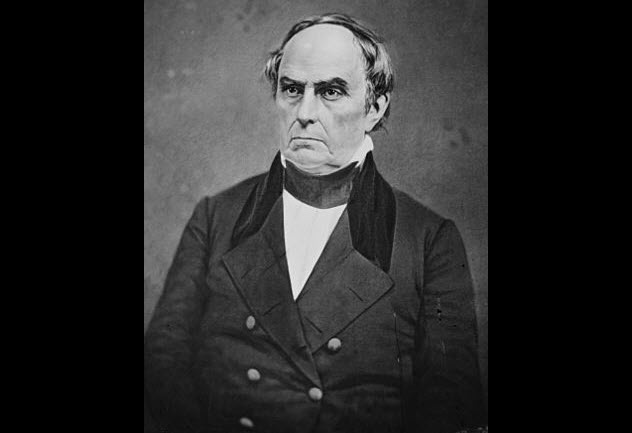 History
History  History
History  Weird Stuff
Weird Stuff 10 Superstitious Beliefs That Once Consumed Entire Cultures
 History
History 10 Bizarre Friendly Fire Incidents in Military History
 Technology
Technology 10 Modern Technologies That Accidentally Imitate Ancient Magic
 Mysteries
Mysteries 10 Mysteries of the Human Genome
 Weird Stuff
Weird Stuff 10 Things So Rare They’ve Only Been Found Once
 History
History 10 Legends Whose Last Moments Undid Their Glory
 Health
Health 10 Futuristic Ideas to Treat Common Medical Problems
 Weird Stuff
Weird Stuff Ten Surreal Attempts to Reverse Baldness
 Facts
Facts 10 U.S. Government Contingency Plans for the Unthinkable
 History
History 10 Odd Things Colonial Americans Kept at Home
 Weird Stuff
Weird Stuff 10 Superstitious Beliefs That Once Consumed Entire Cultures
 History
History 10 Bizarre Friendly Fire Incidents in Military History
Who's Behind Listverse?

Jamie Frater
Head Editor
Jamie founded Listverse due to an insatiable desire to share fascinating, obscure, and bizarre facts. He has been a guest speaker on numerous national radio and television stations and is a five time published author.
More About Us Technology
Technology 10 Modern Technologies That Accidentally Imitate Ancient Magic
 Mysteries
Mysteries 10 Mysteries of the Human Genome
 Weird Stuff
Weird Stuff 10 Things So Rare They’ve Only Been Found Once
 History
History 10 Legends Whose Last Moments Undid Their Glory
 Health
Health 10 Futuristic Ideas to Treat Common Medical Problems
 Weird Stuff
Weird Stuff Ten Surreal Attempts to Reverse Baldness
 Facts
Facts 10 U.S. Government Contingency Plans for the Unthinkable
10 Old-Timey Murders With Twists Worthy Of Sherlock Holmes
Victorian writers such as Edgar Allan Poe and Arthur Conan Doyle invented the mystery story, and they had plenty of real-life material from which to draw their plots. In their shadowy world of horse-drawn vehicles, oil lamps, and binding proprieties, death could come suddenly—one way or another.
10 The Case Of The Disappearing Passenger

One July evening in 1864, two men stepping into a first-class train compartment in Hackney, England, stumbled upon a scene of carnage. Blood on the seats and on the door but nobody within—more specifically, no body within. Women in the next carriage even reported having been spattered with red droplets through an open window.
The eerily empty compartment was replete with clues as well as gore. Those included a leather bag, walking stick, and beaver hat. Eventually, the battered body of a still-breathing, 70-year-old banker named Thomas Briggs was found along the tracks, but he died shortly thereafter.
Acting on tips from a jeweler and cabbie, Inspector Richard Tanner pursued a suspect named Franz Muller to New York. Besides leaving his own beaver hat at the crime scene, Muller apparently had been dim-witted enough to keep the silk top hat and gold watch he’d stolen from the victim. His hanging turned into such a spectacle that public executions were banned shortly thereafter.
9 The Case Of The Dog Who Barked In The Nighttime

Victorian England was shocked when Savile Kent, the three-year-old son of wealthy factory commissioner Samuel Kent, disappeared from his nursemaid’s room in Rode one night in June 1860. Although a family dog had barked, unlike the famously silent one in a Sherlock Holmes tale, nobody had paid the animal any attention. His throat cut, the boy’s body was discovered the following day in an outhouse.
After the local police botched the investigation by concentrating on the nursemaid, Scotland Yard detective Jonathan Whicher was called in. He accused Kent’s 16-year-old daughter, Constance, instead. However, nobody was willing to believe that the teenage half sister of the victim could be guilty of such a horrendous crime.
They had to change their minds when she confessed five years later and ultimately spent 20 years in prison before relocating to Australia. Apparently, she had resented her father’s second wife, a governess who had taken the place of his insane first wife. Also apparent is that people should have listened to Whicher—and the dog.
8 The Case Of The Stickily Suspicious Flypapers

Florence Maybrick was an American Southern belle who’d married an Englishman named James Maybrick more than twice her age. A hypochondriac, James made a habit of imbibing small amounts of poison as tonics.
When he died in Liverpool in spring 1889, no one could tell for sure whether the arsenic found in his system had been administered by him or by someone else. After all, doctors were also in the habit of prescribing poisons to their patients.
Florence had been seen soaking arsenical flypapers in water and was having an affair, so she came under suspicion. She had a good excuse, though, claiming to be making a cosmetic wash for her face. Although she was sentenced to hang, the public’s objection to the unfairness of that verdict caused her to be consigned to prison for 15 years instead. Whether she really was guilty is anybody’s guess, though there seems to have been lots of room for reasonable doubt.
7 The Case Of The Manor Murders

Although manor house killings are more common in mystery stories than in real life, a double murder did occur at Stanfield Hall, Norfolk, England, in November 1848. The hall’s owner, Isaac Jermy, stepped out his front door to get some fresh air after dinner one evening while his teenage daughter, his married son, and his son’s wife made their way to the drawing room.
The senior Jermy was hit and killed by a shot from the darkness. A disguised intruder then burst into the servants’ quarters. He brushed past the butler in a hallway and continued to the main part of the house. There, he shot to death Jermy’s son who had just opened the door to that hallway.
Having crossed toward the dining room, the killer next shot young Jermy’s wife in the arm as she emerged from the drawing room. A maid coming to her assistance was hit in the leg. The teenage Miss Jermy wisely pelted down the servant’s hallway to join the cook, and both fled to the coach house. They sent the coachman to find help.
Despite the intruder’s disguise, several of the servants had recognized him as a tenant farmer named James Blomfield Rush who’d had recent disputes with the Jermys. He was hanged the following April.
6 The Case Where The Butler Did Do It

Murders among the aristocracy also seem more prevalent in novels than reality. However, in May 1840, Lord William Russell rounded off a somewhat erratic life by getting his throat cut while he slept. As the 73-year-old lord was a widower who apparently spent most of his time at his club or abroad, he employed only three household servants: a maid, a cook, and a valet.
When the maid descended the stairs from her room on the uppermost floor one morning, she found a couple of the lower floors in disarray, with bundles of valuables lying about. After she discovered her master murdered in his bed, the police concluded that the slaying was an inside job, probably because any other burglars would have taken the loot with them.
When more stolen items turned up stashed in the pantry, the Swiss valet Francois Benjamin Courvoisier was arrested. To set his crimes to rhyme, he had a previously purloined locket in his pocket and had made off with the plate at an earlier date. He may also have performed some butler duties for the dead man, lending truth to the cliche that “the butler did it.” Once convicted, Courvoisier admitted to committing the murder in a funk over being fired and was hanged only two months after the slaying.
5 The Case Of The Terrifying Tenement

The bodies of siblings Nicholas and Mary Ryan were found one December night in 1873 in or near their single room in a New York City tenement on the building’s fourth floor. Nicholas always slept in the only bed while Mary occupied a mattress propped between the sofa and a couple of chairs. Strangled and with her throat cut, she was discovered in her makeshift sleeping quarters while the body of her brother lay crumpled on the second floor landing of the building. His throat was also cut.
As the two siblings tended to keep to themselves and Mary was found to be pregnant, there was scandalized speculation that the baby might belong to Nicholas. Perhaps he had killed his sister and committed suicide over the shame of it all. However, that didn’t explain a bloody trail which led up the stairs to the roof of the building or the fact that the only knives on hand had no blood on their blades.
As suggested in Professional Criminals of America, it seems more likely that the father of Mary’s child had resented the pressure to marry her and committed the murders to relieve himself of that obligation. Considering where the bodies were found, he had probably killed Mary first, with her brother waking during or shortly after the commission of the crime. Bravely pursuing the killer onto the landing, Nicholas then must have been slaughtered himself, thrown or falling down a couple flights of stairs before the killer escaped over the roofs.
A man with stained sleeves and an agitated demeanor did buy a whiskey at a local saloon that night. Unfortunately, he was never caught.
4 The Case Of The Obvious Overkill

In September 1878, the murder of Mary Stannard in Rockland, Connecticut, appeared bafflingly overdone. Found in the woods near her home, the poor girl had been poisoned and bludgeoned as well as having her throat cut. Fortunately, she’d informed several people about her affair with the Reverend Herbert Hayden, her resulting pregnancy, and her intention to have him procure abortion medicine for her.
When the minister was unable to manage that, he reportedly gave her arsenic instead. Apparently thinking that she wasn’t dying quickly (or quietly) enough, he then used a bludgeon and a knife.
Hayden, who denied everything, was better at testifying than the prosecution’s forensic witnesses, who used too many big words. Or perhaps the jury just didn’t want to believe that a minister could be so cold-blooded. Hayden was acquitted but seemed to give up the ministry afterward. Mary’s pregnancy turned out to be a cyst rather than a baby.
3 The Case Of The Headless Corpse

When a decapitated female body turned up on a farm near Fort Thomas, Kentucky, in February 1896, authorities concluded that the head had been removed to prevent identification. Fortunately, the deceased had size-three feet and was eventually identified as Pearl Bryan through her unusually tiny shoes.
Her parents had believed that she had gone to stay with a friend. In reality, she had visited a former suitor, Scott Jackson, in Cincinnati to demand that he—a dental student—procure an abortion for her. He and his roommate, Alonzo Walling, eventually were convicted of her murder. However, both men insisted that Bryan had died during an abortion performed by a local doctor and that they had simply hidden her body to cover it up. Cocaine had been found in the girl’s stomach, which might lend some credence to their story because cocaine was occasionally used as an anesthetic back then and sometimes caused deaths.
This actually seems more likely than the prosecution’s contention that the two men hired a cab to take them into the country, where they presumably killed Bryan. What would be the roommate’s incentive to involve himself in such a brutal crime, and why would the men be stupid enough to take a cab to a murder scene? Whether guilty or not, both were hanged for their part in Bryan’s death.
2 The Case Of The Devilish Plot And Daniel Webster

The April 1830 murder of a wealthy, 82-year-old former shipmaster, Captain Joseph White, was famous both for the prosecutor in the case and the town in which the murder occurred—Daniel Webster and Salem, Massachusetts, respectively. Although White was bludgeoned and stabbed to death in his bed, none of his valuables seemed to have been disturbed.
Eventually, informers implicated Joe Knapp, the husband of the victim’s grandniece, and Knapp’s brother Frank. If White had died without a valid will, the two men believed that his estate would be divided among all his relatives, including Joe’s mother-in-law. Therefore, Joe stole what he thought to be the most recent will and hired two other brothers to kill White.
The black sheep of a prominent family, Richard and George Crowninshield had agreed to do the job for $1,000. In an act which he apparently believed would save his coconspirators, Richard—the man indicted for the actual murder—hanged himself before his trial. However, with an orator like Daniel Webster against them, the Knapps didn’t have a chance. Joe had stolen the wrong will anyway. Fortunately for George, he’d been with two prostitutes at the time of the crime and had enough of an alibi to avoid the noose.
1 The Case Of The Unexpected Turkey

Probably the strangest of all the crimes happened to the wealthy Dr. George Parkman of Boston who had made many loans to the respectable Dr. John Webster, a chemistry professor at Harvard Medical School. In November 1849, Parkman began pressing for repayment and promptly disappeared.
A janitor named Ephraim Littlefield had his suspicions because he’d seen Parkman and Webster arguing on the day of Parkman’s disappearance. Those suspicions were heightened when Webster gave the janitor a turkey for Thanksgiving. Apparently, the professor usually wasn’t so generous, so his gift was construed as a bribe. After a reward was offered in the Parkman case, Littlefield broke into Webster’s assay oven and found human remains there.
Although there were many questionable remains floating around medical schools in those days due to the grave robbers who supplied such institutions with cadavers, these remains hadn’t been treated with preservatives. Before he was hanged, Webster confessed to hitting Parkman in a fit of rage and then cutting up the body in a sink. Perhaps if the professor had been a more giving man, his benevolence wouldn’t have aroused suspicions.
Author of the Thyme Will Tell series of mystery novels from WaterBrook Press, a division of Random House, Audrey Stallsmith currently is working on 19th-century whodunits of her own.








